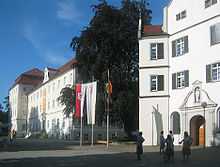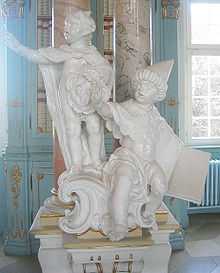Schussenried Abbey
| Imperial Abbey of Schussenried | |||||
| Reichskloster Schussenried | |||||
| Imperial Abbey of the Holy Roman Empire | |||||
| |||||
 | |||||
| Capital | Schussenried Abbey | ||||
| Government | Principality | ||||
| Historical era | Middle Ages | ||||
| - | Abbey founded from Rot an der Rot |
1183 | |||
| - | Granted papal immunity | 13 February 1211 | |||
| - | Gained rights of high and blood justice |
1512 | |||
| - | Mediatised to County of Sternberg-Manderscheid |
1803 | |||
| - | Mediatised to Kingdom of Württemberg |
1806 | |||




Schussenried Abbey (Kloster Schussenried, Reichsabtei Schussenried) was a Premonstratensian monastery in Bad Schussenried, Upper Swabia, Baden-Württemberg, Germany.
History
In 1183 the monastery here was founded by the local landowners, Berengar and Konrad of Schussenried, and was settled from the Premonstratensian Rot an der Rot Abbey.
Pope Innocent III granted it his protection and guaranteed its immunity by a privilege of 13 February 1211. It acquired substantial endowments and built up a considerable territory, and was declared an imperial abbey (i.e., territorially independent) in 1440.
The abbey suffered tremendous damage and losses however in the Thirty Years' War: many of the monastic buildings were burnt down by the Swedes and the lands were largely laid waste.
Sufficient recovery had at length been made by the 18th century for comprehensive re-building to be undertaken, and the present name Neues Kloster ("new monastery") refers to the Baroque re-construction from 1752. The planning was the responsibility of Dominikus Zimmermann. The original plan of four wings with an integrated church was not completely carried out for financial reasons: the present three-winged construction consists of the north wing plus stumps of the intended east and west wings, and represents about a third of the projected building complex.
After the German Mediatisation of 1803 the abbey and its territory was given, in compensation for their losses to the west of the Rhine, to the Counts of Sternberg-Manderscheid, who used the abbey as their castle. In 1806 the territory was mediatised to the Kingdom of Württemberg, to whom the counts' heirs sold the buildings in 1835.
The State of Württemberg set up a foundry on part of the land, and in 1875 a nursing home was set up in the buildings. Until 1997 this was the State Psychiatric Hospital of Bad Schussenried, later known as the Centre for Psychiatry.
Since 1998 the "Neue Kloster" has been used as an exhibition and event centre.
Library
The Baroque library is the most spectacular part of the monastic buildings and one of the main sights of the Oberschwäbische Barockstraße. The room is extremely light. The locked bookcases are arranged in two storeys. The ornamentation is among the richest of the 18th century in the German-speaking world. The ceiling fresco completed by Franz Georg Hermann in 1757 shows in bewildering detail the workings of divine wisdom in apocalypse, scholarship, education and craft.
To the most recent sculptures created for the room belong the eight groups of False Church Teachers, opposite which stand eight large figures of True Church Teachers. They are by Fidelis Sporer and were finished in 1766.
Abbey church
The abbey church is now the parish church, dedicated to Saint Magnus. It contains elements of Romanesque Gothic and Baroque architecture. Among the most noteworthy features are the choir stalls by Georg Anton Macheln and the ceiling frescoes by Johannes Zick showing the life of Norbert of Xanten, founder of the Premonstratensians.
Provosts and abbots
Provosts
- Friedrich 1183-1188
- Mangold 1188-1192
- Menfried 1205-1208
- Luither 1208-1209
- Burkhard 1209-1215
- Konrad I von Besserer 1215-1218
- Rudolf 1221-1222
- Konrad II 1223-1248
- Bertold I 1248-1278
- Ortholf I von Wielin 1278-1281
- Heinrich I 1282-1290
- Albert 1290-1302
- Konrad III 1302-1326
- Ortholf II Schorp 1326-1356
- Bertold II von Altheim 1356-1363
- Johannes I von Veser 1363-1371
- Hiltbrand von Wielin 1371-1404
- Konrad IV 1404-1420
- Johannes II Rothmund 1420-1438
Abbots
- Konrad V Rauber 1438-1466
- Petrus Fuchs 1467-1480
- Heinrich II Österreicher 1480-1505
- Johannes III Wittmayer 1505-1544
- Gallus Müller 1544-1545
- Jakob Renger 1545-1552
- Benedikt Wall 1552-1575
- Oswald Escher 1575-1582
- Ludwig Mangold 1582-1604
- Christoph Müller 1604-1606
- Martin Dietrich 1606-1621
- Matthaeus Rohrer 1621-1653
- Mathias Binder 1653-1655
- Augustin Arzet 1656-1666
- Bernhard Henlin 1666-1673
- Vincentius Schwab 1673-1683
- Tiberius Mangold 1683-1710
- Innocentius Schid 1710-1719
- Didacus Ströbele 1719-1733
- Siardus I Frick 1733-1750
- Magnus Kleber 1750-1756
- Nikolaus Kloos 1756-1775
- Joseph Krapf 1775-1791
- Siardus II Berchtold 1792-1803
References
- Kohler, H. (ed.), 1983. Bad Schussenried. Geschichte einer oberschwäbischen Klosterstadt. Festschrift zur 800-Jahrfeier der Gründung des Prämonstratenserstifts. Sigmaringen: Thorbecke. ISBN 3-7995-4060-1
- May, Johannes, 2000. Die himmlische Bibliothek im Prämonstratenserkloster Schussenried (2nd edn.). (= Marbacher Magazin, Sonderheft 87/1999). Marbach: Deutsche Schillergesellschaft. ISBN 3-933679-27-3
External links
![]() Media related to Schussenried Abbey at Wikimedia Commons
Media related to Schussenried Abbey at Wikimedia Commons
![]() Media related to Schussenried Abbey's Library at Wikimedia Commons
Media related to Schussenried Abbey's Library at Wikimedia Commons
![]() Media related to Schussenried Abbey's choir stalls at Wikimedia Commons
Media related to Schussenried Abbey's choir stalls at Wikimedia Commons
- (German) Schloesser-Magazin: Kloster Schussenried
- (German) German Premonstratensians: Schussenried
- (German) Bad Schussenried town website
| |||||||||||||||||
